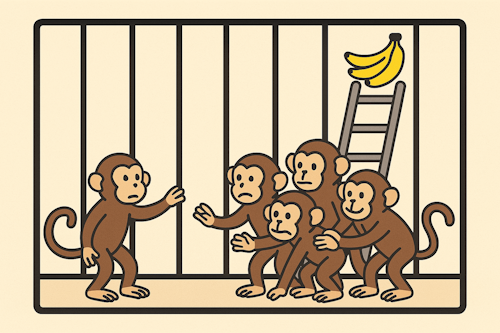The Five Monkeys Experiment
Illustrates Organizational Inertia, Questioning Norms
In Agile coaching, one of the most persistent challenges is not introducing new ideas, but letting go of old ones. Many teams follow rules that no longer make sense, inherited from past leaders, legacy processes, or unexamined assumptions. The Five Monkeys Experiment is a powerful metaphor for how behaviors persist even when the original reason is long gone.

A group of scientists placed five monkeys in a cage. In the middle stood a ladder with bananas on top. Naturally, one monkey began to climb the ladder. As soon as he did, the scientists sprayed all the monkeys with cold water.
Over time, each time a monkey tried to climb the ladder, the others would pull him down and beat him up to avoid getting sprayed. Eventually, none of the monkeys attempted to climb, even though the bananas remained in sight.
Then the scientists replaced one monkey with a new one. This monkey, unaware of the consequences, tried to climb the ladder. The others stopped him and beat him up. He never tried again.
One by one, each of the original monkeys was replaced. Each new monkey learned the rule: “Don't climb the ladder,” even though none had ever been sprayed. By the end, five monkeys sat in the cage, none of whom had experienced the original punishment, yet all continued to enforce a behavior they did not understand.
Lessons Learned
Culture Outlasts Reason
The most dangerous behaviors in an organization are the ones nobody questions. These often show up as phrases like “That's how we've always done it” or “Leadership won't go for that.” The parable shows how unexamined beliefs can become self-perpetuating, even when the original conditions no longer apply.
Systems Shape Behavior
The monkeys didn't act irrationally. They were responding to a system designed to enforce compliance. In organizations, policies, hierarchies, and incentives shape team behavior. Agile transformation is not just about teaching new techniques. It's about redesigning the system that drives old ones.
Fear Is Sticky
Even when the punishment ends, fear remains. Many Agile teams operate under outdated constraints, afraid to challenge assumptions about scope, estimation, or approval processes. Surfacing and releasing these fears is key to enabling real agility.
Reinforcement Builds Culture
Each monkey didn't just learn the behavior. They enforced it. This mirrors how organizational culture spreads: peer pressure, silent disapproval, or subtle signals. Change happens not only through education, but by shifting what is rewarded, modeled, and protected.
New Doesn't Equal Safe
Even newcomers, full of curiosity, quickly conform. Without psychological safety, they'll stop asking “Why?” and start enforcing “What.” Agile thrives when teams protect inquiry and welcome dissent.
Coaching Tips
- Run “What's Our Ladder?” Exercises: In retrospectives, ask teams what habits or rules they follow that no longer make sense. Make space for the quiet “we just do” answers.
- Challenge Process Without Blame: Use this parable to explore why certain rules or workflows exist. Ask, “Who put the ladder there?” and “Do we still need it?”
- Celebrate Small Acts of Courage: When a team member questions an old habit or breaks a pointless rule, spotlight it. Positive reinforcement rewires the culture.
- Don't Replace Monkeys Without Context: When onboarding new team members, take time to explain not just how things work, but why. Otherwise, they'll inherit habits without understanding their purpose.
The Five Monkeys Experiment parable reminds us that not all constraints are real. Some are inherited, some outdated, and some never valid to begin with. As Agile coaches, our role is to help teams unlearn the rituals that no longer serve them and replace fear-based compliance with thoughtful, intentional practice.
Agility isn't just about adding new frameworks. Sometimes, it begins with asking, “Why do we still do that?”


